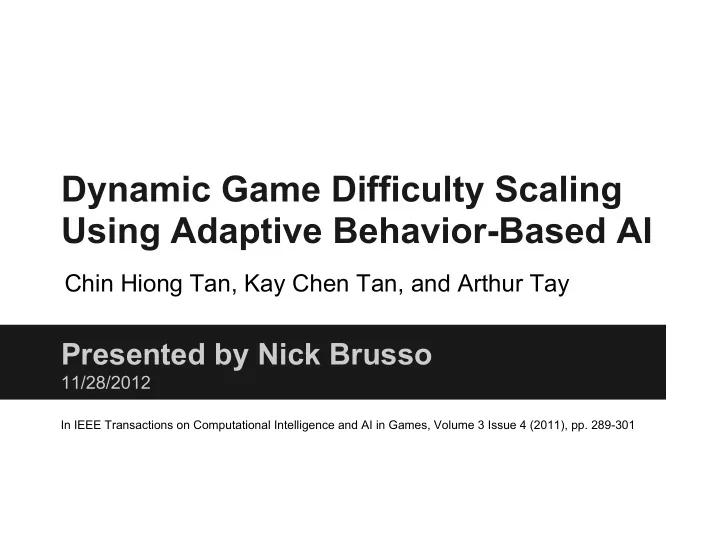

Dynamic Game Difficulty Scaling Using Adaptive Behavior-Based AI Chin Hiong Tan, Kay Chen Tan, and Arthur Tay Presented by Nick Brusso 11/28/2012 In IEEE Transactions on Computational Intelligence and AI in Games, Volume 3 Issue 4 (2011), pp. 289-301
Objective ● Create an entertaining game AI ○ Satisfying to play against for a wide audience ○ High replay value ● Adapt game AI as the player plays ○ Dynamically scale difficulty in real-time ○ Two implementations are presented; I focus on the simpler one.
Game Environment ● Simulated car racing ○ Current is worth 1 point ○ Second is worth 0 points ○ After Current is passed, Second → Current, NewWaypoint → Second ● Objective: gain the most points in a set time. ● Cars can move outside window boundaries ○ Advantageous for the AI
Game Environment ● Control actions (on/off): ○ Accelerate, Decelerate, Left Turn, Right Turn, Neutral ○ A player would use the arrow keys ● Car physics: ○ Collisions between cars ○ Side skidding
AI Behavior Components ● Driving Behavior ○ Speed Regulator ○ Reversing ○ Direction Switching Compensation ○ Tight Angle Turning ● Tactical Behavior ○ Waypoint Prediction ○ Time Wasting ○ Blocking
Adaptive Controllers ● Satisfying gameplay experience ○ Over n games, |Wins - Losses| and Draws minimized ○ |p1Score - p2Score| minimized and max ( p1Score, p2Score ) maximized ● Artificial Stupidity ○ Force the AI to make deliberate mistakes ■ Selectively activate/deactivate behavior components. ■ Requires that the AI is overdesigned (small window for the player in this case)
Adaptive Uni-Chromosome Controller (AUC) ● Stores one chromosome which encodes seven real numbers (probabilities of activating each behavior) ○ Expected behavior set encoded by the chromosome represents a "winning" strategy ● Chromosome is initialized to random values when the game begins. ● Chromosome is updated whenever a waypoint is passed, and a new behavior set is selected using probabilities. ○ If we lost the previous waypoint, probabilities are used as-is ○ If we won, probabilities are complemented before selection
Adaptive Uni-Chromosome Controller (AUC) ● AUC Update Algorithm ○ win_i : probability that behavior i is activated in the next phase. ○ myDist , otherDist : distances from each car to the waypoint. ○ sgn(behavior_i) : 1 if activated, -1 if not activated ○ l and m : learning and mutation rates ( l = 0.1, m is unused)
Testing The full controller (all behaviors enabled) and AUC were both tested against five static controllers: ● Heuristic Controller (HC) ○ Uses simple rules to collect as many waypoints as possible; ignores opponent ● Neural Network Controller (NNC) ○ 9 Inputs: own orientation, opponent orientation, own speed, angle to current , angle to second , distance to current , distance to second , angle to opponent, distance to opponent ○ 2 Outputs: steering control, driving control ● Reverse Enabled Controller (RC) ○ Behavior controller with only reversing and direction switching behaviors active (subset of full controller) ○ Constant speed used instead of speed regulator behavior
Testing The full controller (all behaviors enabled) and AUC were both tested against five static controllers: ● Predictive Slow Controller (PSC) ○ Same as the Heuristic Controller with the Waypoint Prediction behavior activated ○ Slow constant speed used (5px per time step); This prevents skidding and overshooting the waypoint ● Predictive Fast Controller (PFC) ○ Same as PSC, with a speed of 8px per time step. ○ Reaches the waypoint faster, but might overshoot
Results (Full Controller)
Results (AUC)
Conclusions ● AUC performed well in creating an entertaining experience. ○ Achieved a score difference of <= 4 for at least 70.22% of games played. ○ Wins/losses were well-distributed ● Deals well with a variety of opponents
Recommend
More recommend